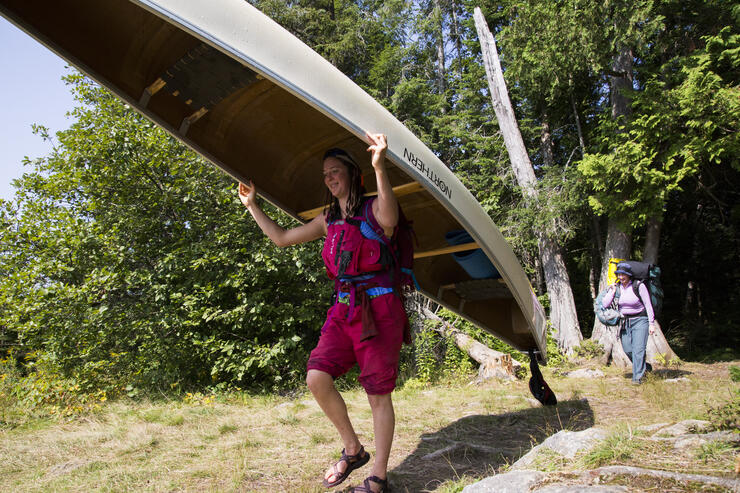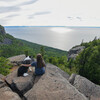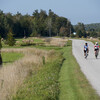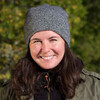
Looking to Paddle the Waters Less Travelled?

In an off-the-grid log cabin down a gravel road just outside the western edge of Ontario’s Algonquin Park, the ring of a dinner bell reverberates across Surprise Lake.
Guests at the cabin, owned and operated by Voyageur Quest, slowly take seats at a long wooden dining table the color of rich peat. Some of us are enjoying day-trips from the cabin, while others are relishing in a last night of luxury before heading into the backcountry of this revered provincial park, home to more than a thousand lakes. Over strip steaks and Dijon-marinated green beans, the conversation turns to the adventure that will begin for some tomorrow—an eight-day canoe trip on the Nipissing River.
The kerosene lanterns in the interior of the cabin throw just enough light on a chalkboard at the end of the dining room table to make out an inventory of wildlife seen so far this summer. Moose, Canadian warbler, blue heron, beaver, squirrel, and many more are included.
Nine days later, waiting for our canoe trip pick-up deep within the park, I think back on that board and mentally create a similar list compiling the inventory of our journey down the Nipissing River. It includes three canoes, one bag of Colombian dark roast, three Jersey Milks, one French Canadian, two scientists, one teenager, 13 kilometers of portaging, one American, 18 cups of hot chocolate, one retired firefighting captain, one vegan, two-first time canoe trippers, and one hell of a thunderstorm. Yet a list is too empirical to convey the experiences between items, to explain the narrative of an adventure into the wooded heart of Algonquin Park and the stories that emerge. This is our story of the Nipissing River.
________
We begin from the dock of Voyageur Quest on Kawawaymog Lake. With paddles in hands, barrels stocked with fresh vegetables, coffee and a dessert for each night, we begin covering the kilometers indicated by each grid on our waterproof park maps. We quickly enter the Amable du Fond River, represented faithfully on the map as a blue squiggle that looks like a polygraph test that isn’t going well. Sterning skills are essential as we come around each hairpin bend. A pair of nicely maintained portages brings us into North Tea Lake, where we are treated to a lavender-hued sunset as we eat quinoa with zucchini and maple glazed trout.

As the sun descends, our group of six begins to learn more about each other. Gerry is a retired firefighting captain and, along with his 18-year-old daughter, Rain, is leading our adventure. Jim is a furniture storeowner and avid traveller, and this will be his first canoe trip. Nathalie, a scientist, is also on her inaugural canoe trip. And Rich, a retired science teacher who drove up from Pennsylvania for this trip, is here for one last backcountry adventure while he’s still young enough. As the famous Algonquin Park stars come out, we sit and talk books—opinions on Joyce, Krakauer, and Faulkner swirling alongside fire smoke.
________
“It’s about to go uphill,” Nathalie says to Jim as he walks with a canoe on his shoulders. Jim is already hiking up a fairly sharp incline, and can’t see the even more dramatic steepness that awaits him.

“This isn’t the uphill?” he asks, exasperated.
We are in the middle of a two-kilometer portage, just fifteen percent of our overall portaging distance. Like all character-building slogs with a canoe on your shoulders, this one has moody changes in elevation, deep mud, and a dedicated crew of resident mosquitoes. As the portage follows the river, mid-size boulders framed by mud provide a crash course in fancy footwork. While portaging, I give a silent thanks to the trail crews for the truly benevolent creation of horizontal logs where a canoe bow can be placed for a rest after especially long hills. We are determined, however, and know that the reward of long portages in Algonquin Park means accessing remote, quiet, and truly special waterways.
A more immediate incentive greets us in the middle of the portage—a backcountry buffet prepared by Rain and Gerry of baba ghanoush, aged Cheddar, tomatoes, cucumber, and soft bread. With full bellies we complete the last kilometer, that much closer to the Nipissing River.

We arrive on Lawren Harris Lake in early evening, a place aptly named for the Group of Seven painter, whose works depicted arrow straight pines and skies melting into dusk just like we see tonight. The lake has a lone campsite, our booked destination for the night. The only problem? As we near we notice two men and a dog on the site. Gerry uses his wilderness manners and chats with the men, explaining we are meant to stay there tonight. The pair was turned back on their original route and this was the only spot they could find. They are happy to share with us, and Gerry shows his gratitude using the classic backcountry currency of chocolate bars.
________
We’re on the Nipissing River and we have a problem.
It’s not a bear—we haven’t seen one yet. It’s not a lack of food—we have more trail mix, expensive cheese, and fruit than we know what to do with. And it isn’t a breakdown in group morale—though the trip is quite challenging, especially for the new canoe trippers, everyone is enjoying the adventure. As Rich tells us every so often, “I’m just happy to be here.”

A spiky pine tree devoid of bark stretches from river left to right, blocking the entire waterway. Foamy surfactant has built up, leaving the water around the tree looking like marshmallows that have lingered too long in hot chocolate.
It’s hard for us to imagine the thousands of trees that moved through this skinny, windy river during the heydays of logging. Beginning in the 1880s, loggers arrived in the park, searching for towering white pines to satiate the demands of the British economy. The men who felled the trees endured a tough lifestyle, living in logging camps, the remains of which still dot the park. Unlike us, they did not enjoy steak, baked potatoes, and popcorn at the end of a long day. Massive felled trees travelled down the Nipissing River, then down the Petawawa River and onto the Ottawa River.
The lone tree that blocks our path is quickly freed as Gerry climbs onto the bank with a saw. After a few minutes of dedicated cutting, the tree is free, yet travelling quickly downstream with the current. We paddle hard to get ahead of the tree, wary of it jamming in another bend and halting our progress again.

The next day we come to a portage that was the site of an old logging camp, and also functioned as a World War II prisoner of war camp. As we bring our canoes and gear to the other side, we notice small, rusted pieces of scrap metal but little else. Eventually we discover a small path through a field of thigh-high ferns, ending at a decaying building whose walls have been so greatly reclaimed by the forest they resemble berms. Bunk bed frames sit inside the collapsed walls, evidence of the work camp that once housed German prisoners of war working in logging. It feels eerie and we don’t stay long.
_____
It has been a summer of rain in the park, and on day five we are grateful for our endless days of sun, but anxious it may end soon. By now we are feeling strong, and the skills of the group have grown significantly. Nathalie portaged her first canoe. Rich has learned the J-stroke and C-stroke and sterns proficiently around 90-degree corners on the always-narrow Nipissing River. We’ve all acquired more backcountry cooking skills from Gerry and Rain. We haven’t seen a single other person since we portaged into this river, a rarity on an Algonquin Park canoe trip the last week of the summer.

At the end of our fifth portage of the day, we sit and discuss whether we should continue. Group energy is low, but we can feel the temperature dropping and see dark sky crawling toward us. Each person shares how they feel and if they want to continue. “I’m just happy to be here,” says Rich. We push on.
In the middle of the trail during our very last portage of the trip, the forest darkens instantly. The first patters of rain hit the maple leaves above us. The Nipissing River opens slowly into the deep, wide expanse of Cedar Lake, and we enter it as a flotilla of pastel-coloured raincoats. Twenty meters from our campsite on the southern shore of Cedar Lake, the rain becomes torrential, and the first vibrations of thunder hit.
Tents are manically yet efficiently erected, two tarps put up and Gerry begins boiling water immediately. We gather around the stove and watch in hungry anticipation as Gerry and Rain prepare mashed sweet potato and black bean burritos topped with cheese and avocado. The west wind violently rolls off the lake, knocking pots and pans over and threatening our tarp, but we are content and quiet in the gale, warm burritos in hands.

We sip hot chocolate under the tarp and stare out at the lake. The group is exhausted and satisfied. Day seven, tomorrow, will be a rest day. We have become a unit, six people who otherwise wouldn’t have met each other. More importantly, the skills and experiences gained on this trip are the potential foundations for years of exploring gems like the Nipissing River and beyond from the seat of a canoe.
This trip was the first part of Voyageur Quest’s 14-Day Crossing Algonquin Park Canoe Trip. The full trip includes an additional six days of whitewater canoeing on the Petawawa River.
Recommended Articles
5 Trails Less Travelled

Best Valentine’s Day Ever

How wilderness art can enrich your life

Love dogs?

Big views, no big backpack

Best Waterfalls in Ontario

Rock Climbing

Want to go snowshoeing?

watch World's top canoeing short film

Best Backcountry Camping in Ontario

Get Hooked in Algonquin
Can't-Miss Skating Trails & Outdoor Rinks

Feelin' the Vibe

No roughing it on this guys getaway

Skills Video: How to launch & land with style

Video: Feel the rush

Tired of Traffic jams?

60 Rugged KMs with kids?

SPring Wildflower Glory




















